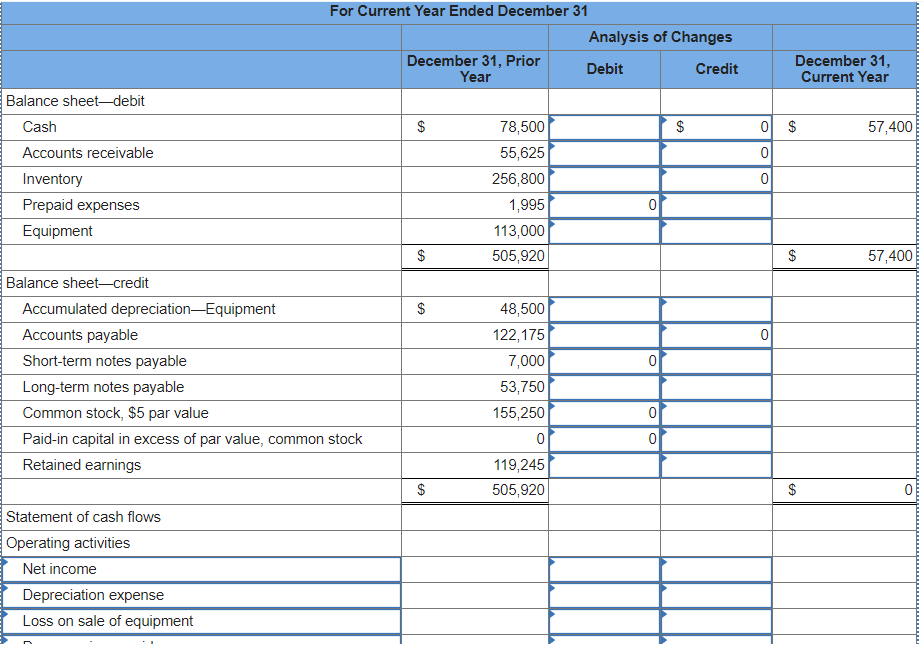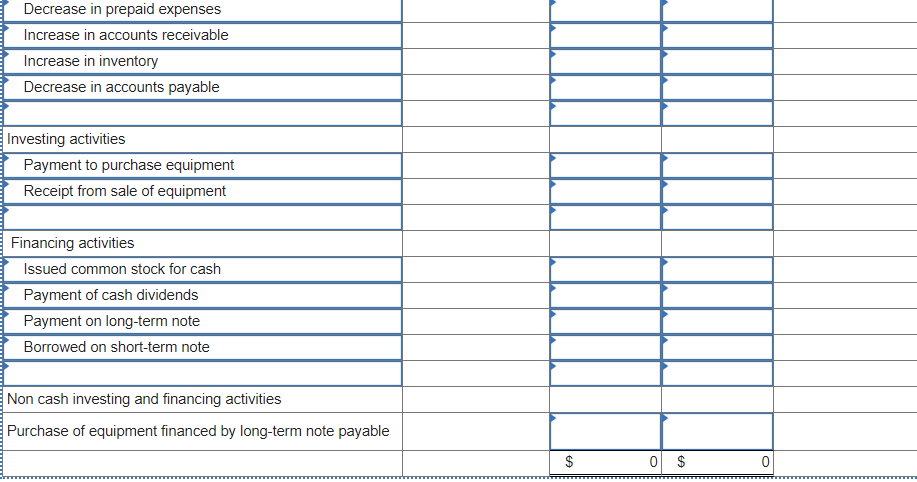Question
Forten Company's current year income statement, comparative balance sheets, and additional information follow. For the year, (1) all sales are credit sales, (2) all credits
Forten Company's current year income statement, comparative balance sheets, and additional information follow. For the year, (1) all sales are credit sales, (2) all credits to Accounts Receivable reflect cash receipts from customers, (3) all purchases of inventory are on credit, (4) all debits to Accounts Payable reflect cash payments for inventory, and (5) Other Expenses are paid in advance and are initially debited to Prepaid Expenses.
| FORTEN COMPANY Comparative Balance Sheets December 31 | |||||||||||
| Current Year | Prior Year | ||||||||||
| Assets | |||||||||||
| Cash | $ | 57,400 | $ | 78,500 | |||||||
| Accounts receivable | 73,320 | 55,625 | |||||||||
| Inventory | 283,156 | 256,800 | |||||||||
| Prepaid expenses | 1,260 | 1,995 | |||||||||
| Total current assets | 415,136 | 392,920 | |||||||||
| Equipment | 152,500 | 113,000 | |||||||||
| Accum. depreciationEquipment | (39,125 | ) | (48,500 | ) | |||||||
| Total assets | $ | 528,511 | $ | 457,420 | |||||||
| Liabilities and Equity | |||||||||||
| Accounts payable | $ | 58,141 | $ | 122,175 | |||||||
| Short-term notes payable | 11,500 | 7,000 | |||||||||
| Total current liabilities | 69,641 | 129,175 | |||||||||
| Long-term notes payable | 62,500 | 53,750 | |||||||||
| Total liabilities | 132,141 | 182,925 | |||||||||
| Equity | |||||||||||
| Common stock, $5 par value | 170,250 | 155,250 | |||||||||
| Paid-in capital in excess of par, common stock | 45,000 | 0 | |||||||||
| Retained earnings | 181,120 | 119,245 | |||||||||
| Total liabilities and equity | $ | 528,511 | $ | 457,420 | |||||||
| FORTEN COMPANY Income Statement For Current Year Ended December 31 | |||||||
| Sales | $ | 607,500 | |||||
| Cost of goods sold | 290,000 | ||||||
| Gross profit | 317,500 | ||||||
| Operating expenses | |||||||
| Depreciation expense | $ | 25,750 | |||||
| Other expenses | 137,400 | 163,150 | |||||
| Other gains (losses) | |||||||
| Loss on sale of equipment | (10,125 | ) | |||||
| Income before taxes | 144,225 | ||||||
| Income taxes expense | 31,250 | ||||||
| Net income | $ | 112,975 | |||||
Additional Information on Current Year Transactions
- The loss on the cash sale of equipment was $10,125 (details in b).
- Sold equipment costing $61,875, with accumulated depreciation of $35,125, for $16,625 cash.
- Purchased equipment costing $101,375 by paying $40,000 cash and signing a long-term note payable for the balance.
- Borrowed $4,500 cash by signing a short-term note payable.
- Paid $52,625 cash to reduce the long-term notes payable.
- Issued 3,000 shares of common stock for $20 cash per share.
- Declared and paid cash dividends of $51,100.
Prepare a complete statement of cash flows using a spreadsheet using the indirect method. (Enter all amounts as positive values.)


For Current Year Ended December 31 Analysis of Changes December 31, Prior Year Debit Credit December 31, Current Year $ $ 0 $ 57,400 0 Balance sheet-debit Cash Accounts receivable Inventory Prepaid expenses Equipment 0 78,500 55,625 256,800 1,995 113,000 505,920 $ $ 57,400 $ 0 0 Balance sheet-credit Accumulated depreciation-Equipment Accounts payable Short-term notes payable Long-term notes payable Common stock, $5 par value Paid-in capital in excess of par value, common stock Retained earnings 48,500 122,175 7,000 53,750 155,250 0 Olo 119,245 505,920 $ $ 0 Statement of cash flows Operating activities Net income Depreciation expense Loss on sale of equipment Decrease in prepaid expenses Increase in accounts receivable Increase in inventory Decrease in accounts payable Investing activities Payment to purchase equipment Receipt from sale of equipment Financing activities Issued common stock for cash Payment of cash dividends Payment on long-term note Borrowed on short-term note Non cash investing and financing activities Purchase of equipment financed by long-term note payable $ 0 $ 0 For Current Year Ended December 31 Analysis of Changes December 31, Prior Year Debit Credit December 31, Current Year $ $ 0 $ 57,400 0 Balance sheet-debit Cash Accounts receivable Inventory Prepaid expenses Equipment 0 78,500 55,625 256,800 1,995 113,000 505,920 $ $ 57,400 $ 0 0 Balance sheet-credit Accumulated depreciation-Equipment Accounts payable Short-term notes payable Long-term notes payable Common stock, $5 par value Paid-in capital in excess of par value, common stock Retained earnings 48,500 122,175 7,000 53,750 155,250 0 Olo 119,245 505,920 $ $ 0 Statement of cash flows Operating activities Net income Depreciation expense Loss on sale of equipment Decrease in prepaid expenses Increase in accounts receivable Increase in inventory Decrease in accounts payable Investing activities Payment to purchase equipment Receipt from sale of equipment Financing activities Issued common stock for cash Payment of cash dividends Payment on long-term note Borrowed on short-term note Non cash investing and financing activities Purchase of equipment financed by long-term note payable $ 0 $ 0
Step by Step Solution
There are 3 Steps involved in it
Step: 1

Get Instant Access to Expert-Tailored Solutions
See step-by-step solutions with expert insights and AI powered tools for academic success
Step: 2

Step: 3

Ace Your Homework with AI
Get the answers you need in no time with our AI-driven, step-by-step assistance
Get Started


